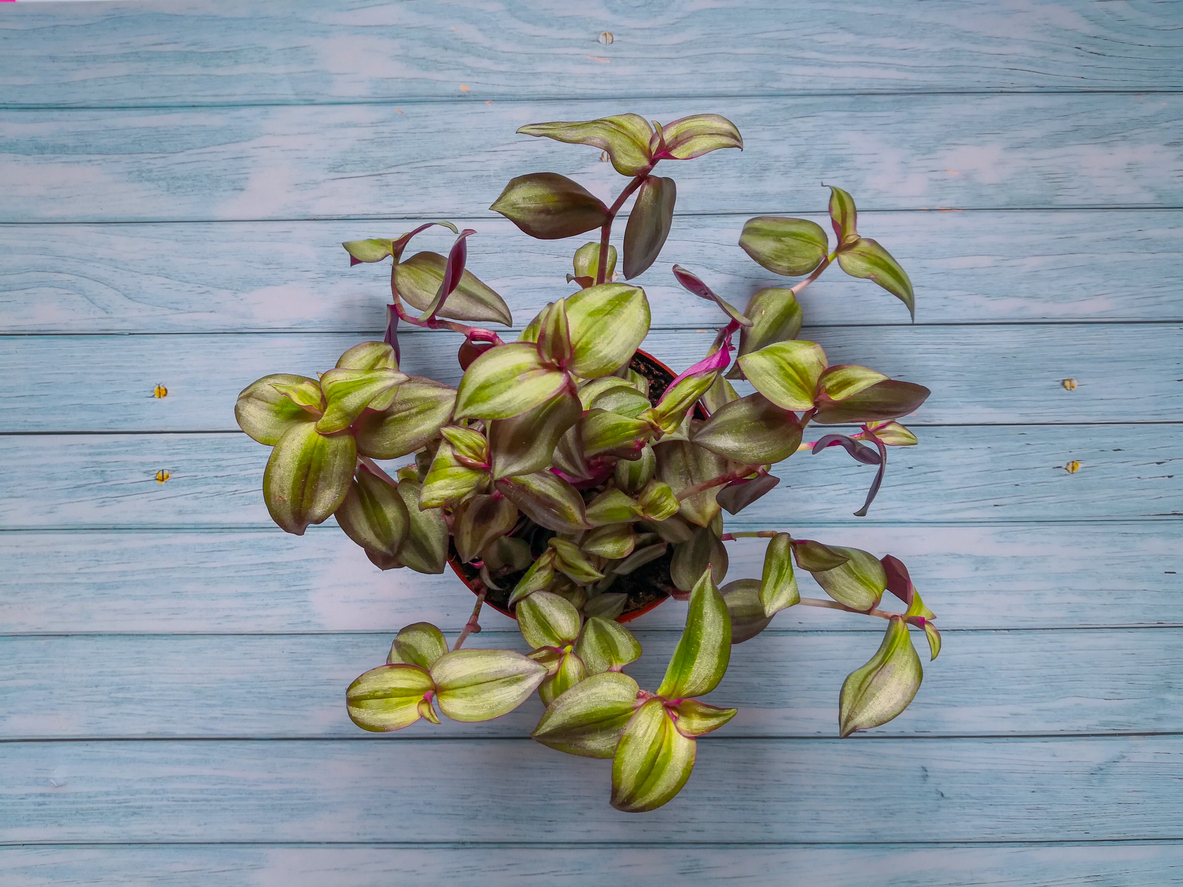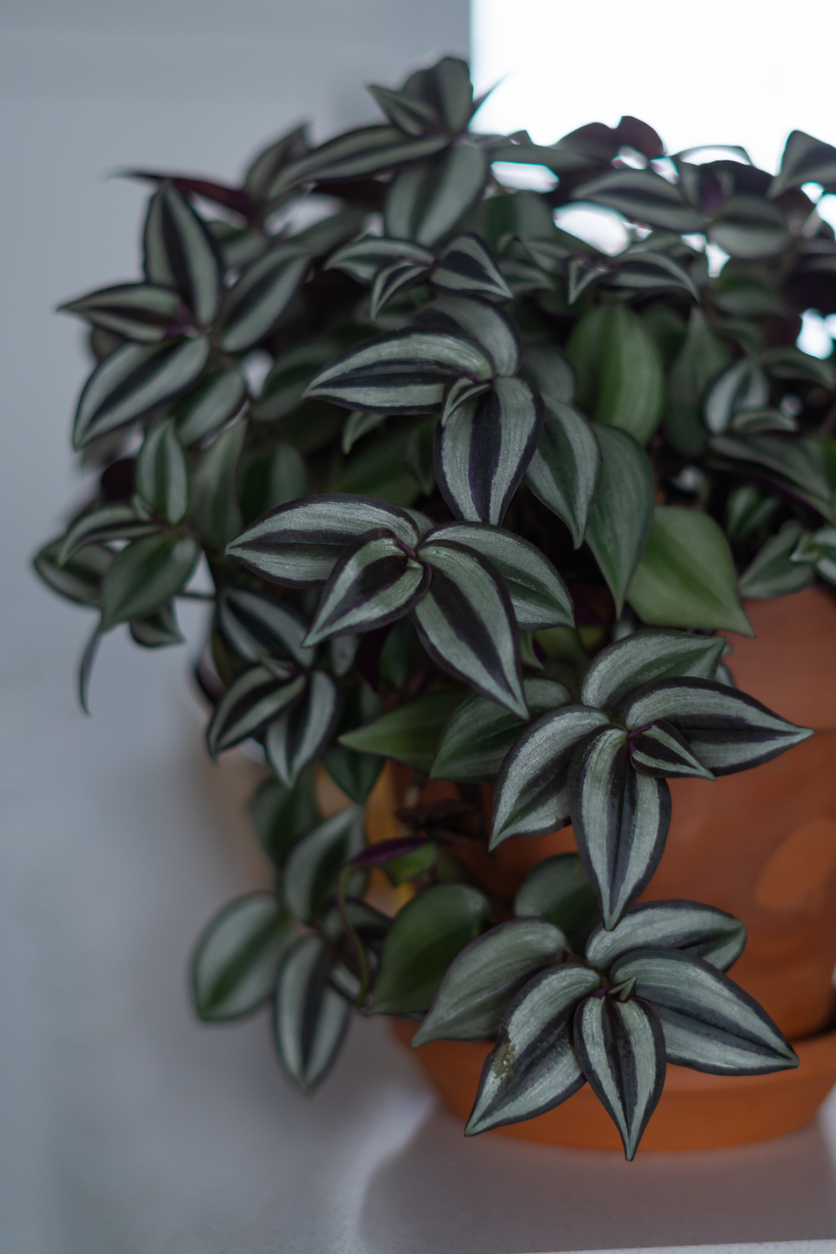

We may earn revenue from the products available on this page and participate in affiliate programs. Learn More ›
Also known as spiderwort, the inch plant thrives indoors and is easy to propagate. One reason for its popularity is that inch plant care is relatively easy. “Inch plants are popular for [their] trailing habits and because [they are] very low maintenance,” says Rich Christakes, founder of ShipMyPlants.com. They are also popular for their colors, ranging from pink to purple and silver, which adds contrast to an indoor garden. The creeping inch plant’s trailing tendrils are especially attractive when the plant grows in a hanging basket.
Inch Plant Care at a Glance
Common Name: Inch plant, spiderwort, wandering dude
Scientific Name: Tradescantia
Soil: Well-draining potting soil; pH 6 to 8
Light: Partial shade or indirect light
Water: Consistently moist
Food: Little, if any, water-soluble fertilizer
Temperature and Humidity: 65 to 75 degrees Fahrenheit (or warmer), high humidity
Propagation: Stem cuttings
Safety: Toxic to dogs, cats, and horses; can be irritating to humans
Inch Plant Characteristics
Used as a ground cover in warm climates, the inch plant also is popular as a houseplant because of its colorful foliage and its rugged determination. It’s hard to kill this plant. It’s so tough, in fact, that it can take over planting beds, choking out other plants.
Inch plants can be leggy or bushy, and will benefit from pruning or pinching back elongated stems. Given the right conditions, inch plant flowering can occur, but with this plant, the foliage takes center stage.
The plant takes its name from the nodes that grow along its stems, which are supposed to be spaced an inch apart. Each node can root to produce a new plant. With propagation so easy, this fast-growing plant can multiply quickly. It’s possibly the perfect plant: pretty, easy to propagate, versatile, and unfussy.

Types of Inch Plants
There are four main types of striped inch plant, designated by the color of their leaves. All come from the Commelinaceae family of trailing succulents originating in Mexico, South America, and the Caribbean. A few of the more common types include:
- Tradescantia fluminensis: The giant white inch plant features white stripes or variegation on the tops of its leaves, with purplish undersides. It typically doesn’t grow higher than 8 to 9 inches, making for a compact trailing plant.
- Tradescantia pallida: Commonly known as Purple Heart because of the color of its foliage, this purple inch plant produces small lavender flowers for an eye-catching drench of color.
- Tradescantia fluminensis ‘Nanouk’: This spiderwort shows pink, white, purple, and green stripes on its leaves atop upright stems. A vigorous grower, it can produce small white flowers.
- Tradescantia callisia: The pink inch plant, also known as the pink lady plant or pink panther, features bright green leaves with narrow pink stripes.
- Tradescantia zebrina: The silver inch plant is identified by its almost iridescent purple and silver leaves. With sufficient light, it will produce tiny purple flowers.
Selecting Soil for Inch Plants
Inch plants prefer well-draining, moist potting soil. To keep soil from becoming boggy, it’s advised to add 1 part perlite to 3 parts all-purpose commercial potting mix. Adding organic material to the soil can aid in drainage. “Like most other houseplants, well-draining soil is always the best option to prevent root rot,” Christakes says.
Because the inch plant grows quickly, it’s important to check regularly to see if the plant is rootbound. When that happens, it’s time to replant in a larger pot, using the same type of soil and watering it well—but not overwatering.

The Right Light
Inch plant light requirements range from partial shade to indirect light. While insufficient light dulls the colors of the foliage and produces “leggy” plants, too much direct light can scorch the leaves. If the variegation of the leaves fades, it’s a sign of insufficient light.
Indoors, the plants should be near a window that gets 8 hours of bright but indirect sunlight per day. Bright light will encourage vibrant colors and a compact shape. If placed directly in a south- or west-facing window, use sheer curtains or other plants to soften the effects of strong light so the plant won’t burn.
Watering Inch Plants
“Inch plants enjoy a good watering,” Christakes notes, “but be careful not to overwater.” They prefer to be consistently moist. However, while the indoor plants don’t like to dry out, they won’t respond well to sitting in wet and boggy soil. Too much watering can result in root rot.
A good rule of thumb would be to water when the top inch of soil feels dry to the touch, Christake says, but don’t let it dry out completely. If the plant dries out, the lower leaves turn yellow, then brown, then crispy. Curling leaves could indicate improper watering or a number of other issues, such as poor light.

Fertilizing Inch Plants
Inch plants don’t need regular fertilizing, and you can skip fertilizing altogether in the winter. “Inch plants would benefit from an occasional fertilization,” Christakes agrees. He suggests a balanced, water-soluble fertilizer, dosed at half the recommended strength every 4 to 6 weeks, spring through fall.
Overfertilizing can result in stunted growth or discoloration of the leaves. It can also “burn” the roots, preventing efficient water uptake. Roots can become more susceptible to disease and overall plant health can decline. Excess fertilizer should be flushed from the soil.
Setting the Temperature and Humidity
“Inch plants are not super finicky when it comes to temperature and humidity,” Christakes says. While they love above-average moisture levels, they can thrive in standard indoor humidity levels. During winter months when the furnace is on, they can benefit from misting lightly every few days, or being placed in the more humid rooms, such as the bathroom or kitchen. A small humidifier positioned nearby can make them happy in almost any room.
All species of spiderwort plants do well in temperatures between 65 and 75 degrees Fahrenheit. They also can flourish in warmer temperatures, but will not appreciate sustained temperatures below 50 degrees Fahrenheit. Kept at such low temperatures, their leaves may become discolored or otherwise damaged.
Propagating Inch Plants
Inch plant propagation is easy. They are one of the quickest to propagate, with roots often appearing in a day or two.
Because these plants can get leggy, they need to be pinched back from time to time to keep them looking their bushy best. After removing a few stems, strip the lower leaves and place them in water in a sunny spot. Cuttings should be about 3 to 4 inches long, with the cut just below a node. Once roots begin developing from the nodes (average of about a week), plant in well-draining potting soil and place in a location that receives indirect light. Alternatively, you can plant the cuttings directly in moist soil. Expect to see new growth within weeks.
It’s a good idea to propagate new plants, because the inch plant lives only a few years.

Safety Considerations
While some experts insist that the inch plant is safe around cats, the ASPCA lists this plant as toxic to dogs, cats, and horses. Christakes says, “Inch plants can have a mild toxicity to people and animals if ingested, so it is best to keep them out of reach of small children and curious pets.” But if you have tortoises or other reptiles, it’s considered an edible plant.
The sap in the leaves and stems can be irritating and even cause dermatitis. If ingested, some varieties can cause vomiting, abdominal pain, or diarrhea. In addition to those symptoms, cats can experience drooling or seizures after ingesting inch plant. Dogs can also develop drooling, along with a rash and breathing issues after ingestion. It can cause allergic reactions in dogs.
Potential Pests and Diseases
Spiderworts don’t aren’t known for having serious pest infestations or diseases. Nevertheless, Christakes states, they can be susceptible to the “normal houseplant pests and diseases: aphids, spider mites, scale insects, root rot from overwatering, fungal leaf spots if the humidity is too high, and powdery mildew.”
Most of these pests and diseases are not fatal to the plant, but left unchecked, they can cause damage and wilt, or curtail healthy growth. Neem oil, insecticidal soap, fungicide, or other suitable insecticides are generally efficient in ridding the plant of pests. Removing diseased leaves helps reduce infestations and mold.
Looking for more low-maintenance houseplants? Check out our guides on caring for best houseplants, best indoor plants, and hanging plants.
